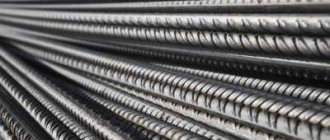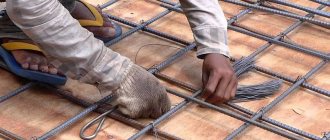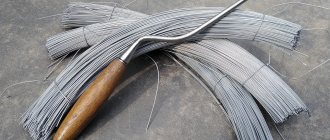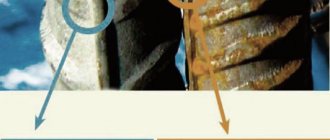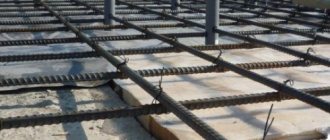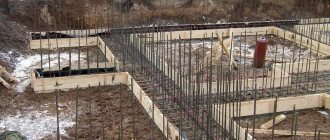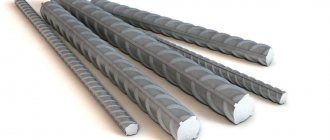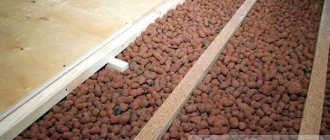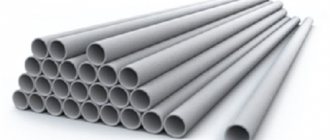Knitting reinforcement
Hook for tying reinforcement
A hand hook can be made from any wire or welding electrode 3-4 mm thick. To make the handle comfortable, you can put a piece of hose on it. It can also be made from a trowel whose blade has broken off. Its end is bent and sharpened. A paint roller handle is also suitable for this. A store-bought crochet hook has a hook that rotates freely in the handle.
You can also use a screwdriver to tie the reinforcement by holding a hook-shaped attachment in its chuck, which you can make yourself from a nail or a 4 mm hexagon. or other similar material. Having secured the nozzle, you need to experimentally determine by eye the rotation speed of the screwdriver so that it twists the wire tightly and does not tear it.
As a rule, 1.2-1.4 mm wire is used for knitting reinforcement with a diameter of 10-14 mm. If you take a thin wire, you will have to fold it twice, because it is rather weak, and a thicker one is difficult to twist.
Sometimes, to speed up the work, it is necessary to measure the circumference of a coil of wire. In some cases, you can immediately cut it and get many finished pieces.
The reinforcement is taken and placed on top of each other in a cross. Then a wire 30-40 cm long is folded in half.
Option one is for tying a slab or for a horizontal layer of reinforcement. At a distance of one third from the loop, the wire is bent around the finger. Then it is slipped under the reinforcement, and a hook must be inserted into the loop. A free piece of wire, bending around the reinforcement, is stretched and placed on the bed of the hook, which spins and grabs the end of the wire. In this case, the hands do not let go of the wire until the hook grabs the wire tightly, then it is released. The number of revolutions is determined experimentally. After twisting the wire, the hook is removed, and the free ends of the wire can be cut off.
The second option is used for a vertical layer of reinforcement; in this method, the reinforcement is fixed, better than in the first option.
In this version, the wire is folded in half, but the rods are tied differently, as in the photo. Then, with your fingers, the wire is pressed tightly against the rod, and the ends of the wire are bent towards themselves, the hook is inserted into the loop and the wire is twisted. The hook is removed, the ends of the wire are bent.
Tying with a screwdriver
Everything is done as described above, but a screwdriver is used. Therefore, you need to get a little familiar with the tool and tying the reinforcement will be easy.
Protective layer retainers
When knitting reinforcement for the slab, cut PVC pipes with a diameter of 40-50 mm can be used as supports for the reinforcement. They are cut like sausage into slices of the required height. You can use a soldering iron to make recesses for the fittings.
Posted by a member of the “House and Dacha” forum amarrak Editor: Adamov Roman
Source
How to make a homemade hook for tying reinforcement
So:
1. You can make a hook yourself or buy a ready-made one. The asking price is 150-200 rubles. Advantages of a purchased one: the steel “body” of the hook rotates freely in the handle, which significantly speeds up the work.
There are models of hooks with bearings, but they are much more expensive than a regular hook with a sleeve.
The advantages of a homemade hook are that you can make it in 10-15 minutes from what you have on hand. For example, a hook for tying reinforcement is made from a “150” nail, an electrode, reinforcement with a diameter of 8 mm, a paint roller holder from which the roller is sawed off, a trowel handle, etc.
There are many options. It all depends on imagination and the presence of “unnecessary” things lying around the household.
Freedom-VUser FORUMHOUSE
I made a homemade hook for tying reinforcement from a steel bar. I ground one end into a cone on a sharpener and bent the rod in two places. Instead of a handle, you can put a piece of tube, it’s more convenient to work, and the glove doesn’t get wrapped around the device.
Another version of a homemade hook is offered by a portal member with the nickname alexdomm. To do this, take an old fork (if, of course, you have one on the farm) and cut off one pin. Next, we take a pipe with a diameter of 16 mm, drive a pin into it and rivet/weld the end. We sharpen the working part on an emery wheel or using a grinder.
Because For the manufacture of forks, hardened steel is used; with such a hook you can twist the “three” wire, and the hook will not straighten out.
SpehFirst used a paint roller to make a homemade hook, from which he cut off everything “unnecessary”.
Another option is to make a hook from a broken or unnecessary trowel.
The principle is the same - we break off or cut off the blade and grind the working part of the hook into a cone.
alex30rusFORUMHOUSE user
I made the hook from smooth figure eight reinforcement. In order for the hook to be quickly removed from the loop, be sure to sharpen it to a cone. We bend the “body” of the hook at an angle of 20 degrees. This increases the rotation speed. For convenience, you can put a piece of hose on the handle.
Knitting wire for fittings, what diameter should I take?
Advantages of using knitting wire:
The production of wire for knitting is regulated by GOST 3282-74 “Low-carbon steel wire for general purposes. Technical conditions". The standard regulates the following points:
Wire with a diameter of 1 mm, heat-treated, high precision, light:
Wire 1.2-P-2Ts-II GOST 3282-74.
Permissible deviations from the diameter are indicated in Table 1 of the specified GOST, mechanical properties are indicated in Table 2.
To determine compliance with GOST, the following tests are carried out:
The wire is made of steel containing carbon up to 0.25%. The final product is obtained from rolled wire using cold drawing. During the production process, the crystalline structure of the surface is deformed. To restore the structure, annealing is used, which helps reduce stress in the metal. Products that have not been annealed are usually brittle and difficult to bend.
There are two types of heat treatment:
Products with a zinc protective coating are marked with class “1C” or “2C”. The second class has a thicker protective layer.
There are several types of galvanizing in the manufacture of protective coatings:
Depending on the presence or absence of a protective coating, knitting wire is divided into:
Source
Knitting reinforcement, wire
When knitting reinforcement, burnt knitting wire with a thickness of 1.2 millimeters is used. The quality certificates indicate its name: heat-treated wire GOST 3282-74.
When purchasing knitting wire, be careful; if you purchase unburned wire with a thickness of more than 1.2 millimeters, you will have to spend more effort and time knitting it with the reinforcement.
The difference between fired and unfired is that if the first bends well, fits tightly to the reinforcement, has the property of ductility (does not break when knitting), then the second, on the contrary, does not press well, does not twist well and breaks.
Knitting wire is sold in coils per kilogram. How to calculate how much wire you will need for a particular volume of reinforcement work?
There are no clear written expenses either in the snips or in the guests. SNiP stipulates the rules for reinforcement overlaps, which must be at least 30 diameters; if you have reinforcement with a diameter of 12 mm, then the overlaps must be at least 36 cm. When using different thicknesses of reinforcement, the consumption will be greater, and the wire may break, which leads to an increase in its volume.
On average, it takes 15-10 centimeters of wire to knit one knot, this is approximately 80-100 grams per square meter from these calculations and order the knitting wire.
I recently encountered this problem myself; I had to order tying wire for 24 tons of reinforcement. At other construction sites they brought it as needed, when it was finished, we went and bought it.
I didn’t know how to calculate, but on one of the Internet resources I found that you need to calculate 15-20 kilograms per 1 ton of metal. It turned out to be 480 kilograms, but it turned out that this was not correct. For concrete floors, 100 grams of wire per square meter is calculated. The total area of concrete floors of 1300 square meters is 1300 x 0.1 = 130 kg. But all these calculations are not accurate and you may need to buy additional binding wire for your volumes.
Preparing the Tie Wire
How to cut wire for tying reinforcement? 30-40 rings of wire are separated from the coil, so that it is convenient to hold. They tie one free end so that it does not fall apart and cut it with a grinder into pieces of 20-30 centimeters. The finished bundles of wire are folded in half and everything can be tied around the reinforcement.
Knitting occurs in this way: we insert a loop under two crossed reinforcements, we put the tails of the wire into the loop and tighten it with a hook.
Is it worth tightening it so that the ends of the wire break and the tails don’t stick out? I haven’t come across rules on this anywhere. There were technical supervisions that required that the ends of the wire not stick out, I believe that this does not affect anything.
If the ends of the wire are broken, there is one big disadvantage: if you reinforced the ceiling and did not remove the remains from the formwork, then all this debris will remain in the concrete and will eventually appear in the form of rust.
How to knit reinforcement - a detailed description of patterns and methods
How to knit reinforcement - a detailed description of patterns and methods
As you know, building concrete can withstand compressive loads well. At the same time, it is torn apart by tensile forces that do not exceed even a tenth of the maximum compressive forces.
That is why, to increase the strength of concrete against tensile and bending influences, steel meshes and reinforced frames are used - connected double meshes, spaced at least 150 mm from each other.
Perhaps you need:
Knitting wire, chopped 1.2x400mm (1300 strands)
Knitting wire, chopped 1.2x400mm (130 knits)
Knitting hook
Reinforcing elements are assembled from corrugated steel reinforcement. Most often, fittings of classes A II and AIII are used for this. The connection of its elements into a spatial reinforcement frame is carried out in two ways - electric welding or knitting wire.
Despite the fact that welding allows you to weld the frame faster than it can be done with viscous welding, the second method is more often used. There are many reasons for this:
Selection of tie wire
The criteria for selecting a harness are as follows:
- Construction technology
. Where the use of welding is not strictly specified, tie wire is used to bind the reinforcement elements. - Terms of Use
. If the material will be influenced by an aggressive environment, then it is better to choose the galvanized variety. - Reinforcement diameter
. The wire for a knitting gun should be thicker, the more massive the structural elements undergoing adhesion. - Price
. Galvanized material is more expensive than usual. Another alternative is copper-nickel alloy wire, but its use is justified only in luxury construction.
Tie wire thickness
This is a very important parameter on which the strength and reliability of the entire building depends. The most popular reinforcement sizes today are 8-12 mm. To knit it, wire with a diameter of 1.2-1.4 mm is used. If a material of a smaller cross-section is used, there is a high risk of its rupture. Black knitting wire with a diameter of 1.6 mm and above will not allow you to tighten the knot so that it does not come apart and remains strong.
How do you knit the reinforcement?
The described disadvantages of the electric-welded reinforced frame do not allow the use of this technology in critical structures. The main technology for manufacturing a reinforcing frame in such objects is the knitting of reinforcement. It is carried out using specially made wire from low-carbon steels St0, St1, St2, St3. The carbon content in it is no more than 0.25%.
The main requirements for knitting wire are strength and ductility. The first is provided by the composition of the steel used for its manufacture. The parameter is the temporary tensile strength. For heat-treated wire (only this type is used for knitting), its value should be 30-50 kgf/mm².
Heat treatment imparts plasticity to the knitting wire. It consists of heating the material to 400-500 ºС (different technologies), holding and cooling in air. In this case, processes of homogenization, recrystallization, and rest of the metal occur. Result:
Wire prepared in this way can be bent, twisted, and pulled many times. It becomes soft, grips the tightened parts well and without the formation of loop voids.
Tie wire is available both uncoated and zinc coated. If it is annealed in a shaft furnace in an air atmosphere, it turns out black because it is covered with the resulting oxides. Annealing in a bell-type furnace in atmospheres of nitrogen, argon and other inert gases produces a light color.
Zinc coated wire is used in concrete where there is a high likelihood of moisture penetration into the structure, such as foundations.
Types of knitting wire
This material differs in:
- The presence or absence of a protective coating
. Galvanized binding wire is kept in baths of molten zinc, due to which it becomes less susceptible to corrosion, which is very important when used in places exposed to aggressive external environments. - Heat treatment
. There are untreated and annealed tows. Annealed knitting wire is marked with the letter “O”. Elevated temperature changes the very structure of the material, reducing the internal stress of the steel and thereby increasing elasticity and mechanical strength. In this case, annealing can be dark or light. The first endows the material with scale. - Strength class
. It is determined by the type of alloys used in manufacturing. Knitting wire V-1 is made from low-carbon steel, but the high-strength analogue V-2 has an increased number of alloying components. A regular cord is used to connect non-tensioned frames, but a strong cord is used to tie the prestressed reinforcement.
This material can be purchased in a skein or in a reel. The first weighs from 15 to 250 kg and consists of one piece of wire. The second has a mass from 500 to 1500 kg. There are no more than three segments in it. Recently, steel knitting wire with rings has become very popular. This building material has the form of a reel, consisting of 1–5 thousand sections 8, 10, 12 or 14 cm long. The ends of each are crowned with rings, which facilitate the work of installers and significantly speed up it.
How to choose knitting wire?
Knitting wire of any standard size has design and physical parameters. Choosing the right option from them is the task of the technical manager of the work. The material must be strong enough to ensure reliable fastening using the chosen knitting method and not tear.
First, you should decide on the thickness of the wire according to the diameters of the reinforcement used for the frame, and then on the amount of wire required to complete the entire work. Depending on what is more important (corrosion resistance, clean hands or price), choose galvanized, light or black wire.
You need to select the wire according to the marking as follows. In the designation “Wire 1.2-O-Ch GOST 3282-74” the letter O is thermally treated (just for knitting), the letter CH is black, 1.2 is the diameter in mm. Light-colored, heat-treated, high-strength wire will be marked as follows: “Wire 1.4-P-O-S GOST 3282-74.” The zinc coating is indicated in the marking by the additional letter “C”.
Characteristics of tying wire
This material is manufactured with a cross-sectional diameter from 0.5 to 6 mm. Stainless steel knitting wire can be galvanized. Then its thickness increases to 10 mm. To increase strength and elasticity, the product is subjected to heat treatment. When choosing a material that has not been fired, it is necessary to take into account the tensile strength (N/mm²) and cross-sectional area:
- 10 mm
– 390-690; - 8 mm
– 390-780; - 4.5–5 mm
– 390-830; - 3.2–4.5 mm
– 440-930; - 2.5–3.2 mm
– 540-1080; - 1–2.5 mm
– 590-1270; - less than 1 mm
– 690-1370.
How to calculate the binding wire?
Knitting wire is sold by weight. How to calculate how much to buy in kilograms? To do this, you need to use a weight-to-length table. One kg of the diameter indicated below in mm contains wire in meters:
Now you can calculate the wire consumption according to the reinforcement frame manufacturing plan, which indicates the number of ties. It must be multiplied by the length of the material in one cut per connection, which is determined experimentally. Based on the total length, we determine the weight of the wire and its price.
Types and comparative characteristics
According to the main characteristics specified in GOST 2333-80, the wire is classified according to the shape and type of section, size, composition, surface treatment and finishing, area of use:
| Rental form | Section size | Chemical composition | Surface treatment | Surface finishing | Destination |
| Round | 1 group: up to 0.1 mm | Low carbon steel (carbon content no more than 0.25%) | Thermal | No additional finishing | Universal, general purpose |
| Shaped | Group 2: 0.1-0.2 mm | Carbon steel (more than 0.25%) | Released | Pulled after turning, grinding, roughing | For reinforcement of stressed metal structures |
| Rectangular | Group 3: 0.2-0.4 mm | Alloy steel | Annealed | Sanded | surfacing |
| Square | Group 4: 0.4-0.8 mm | High alloys | Normalized | Polished | Welding |
| Triangular | 5 group: 0.8-1.6 mm | Special types of alloys: heat resistant; corrosion resistant; heat resistant; precision. | Combined (tempered hardened) | Etched | Spoke |
| Trapezoidal | 6 group: 1.6-4 mm | Patented | With a metallic finish: · tinned; · with galvanization; · with copper coating; · coated in aluminum or brass. | Ropeway | |
| Hexagon | 7 group: 4-6 mm | Stabilized (processing under voltage) | With a finishing non-metallic coating (phosphated, with polymer painting) | For flexible pull of arrows and signals | |
| Oval | 8 group: 6-8 mm | Unheated | Treated light with tarnished colors | For reinforcing products of various types | |
| Z-shaped | 9 group: more than 8 mm | Cold rolled | Heat treated black with scale | Spring | |
| Segmental | Cold drawn | String; For the production of reinforcing mesh | |||
| X-shaped | Heat drawn (hot rolled) | For the production of cables of various types and purposes | |||
| Special profile | Calibrated | Bandage | |||
| Periodic profile | Linking |
The most commonly used wire types are:
● made of low-carbon steel (universal, complies with GOST 3282-74);
● made of low-carbon steel, cold-drawn (used for knitting and reinforcing concrete products, complies with GOST 6727-80);
● carbon steel (used for stressed reinforced concrete structures, knitting metal frames, complies with GOST 7348-81);
● welding steel (universal, complies with GOST 2246-70);
● made of low-carbon steel (general purpose, complies with GOST 3282-74).
Surface type and finish can be customized according to customer's requirement. Most often, standard black wire is used, but when in contact with aggressive environments, light galvanized wire or with protection in the form of polymer painting is recommended. Protective coating of copper, brass, and aluminum is also allowed to impart the required properties to the rolled product.
How to crochet reinforcement correctly?
There are quite a lot of techniques, methods and answers to the question of how to knit reinforcement with knitting wire. Automatic devices, power tools, mechanized equipment, hand tools, and homemade products are used.
One of the most common methods of connecting reinforcement is crocheting. It is performed with an inexpensive tool - a crochet hook, which you can make yourself, but it is better to use an industrial one.
The tool consists of a polyamide cylindrical handle, through the axis of which the body of the steel hook itself is passed; it rotates freely in the handle. The end of the hook is bent relative to the axis of the handle by approximately 80º, and the axis of rotation of the pharynx itself is shifted from the axis of the handle by 4-10 cm (designs vary). You can learn to use the tool correctly in just a few matings; skills are acquired by the end of the first working day.
The automatic crochet method has also become widespread. It consists of a rod with a screw notch, at one end of which there is a hook. The rod moves inside a screw plastic cage with rotation. If you hook the wire with a hook, as described above, and pull the clip towards you, the rod with the hook will rotate, performing the knitting. The clip is reversible - if you release it, it returns to its original position. You can knit reinforcement with an automatic crochet faster than with a crochet hook, but it costs more.
Hook for tying wire
Installers do not work with the material with their bare hands; they have a special tool for tying wire. It can also be different:
- Hook
. On sale you can find a variety of options for this device, ranging from the simplest to semi-automatic analogues. - Gun
. This is a modern tool that allows you to fully automate the knitting process. One press of a button and the connection is complete. However, not every builder can afford to buy it.
Help with a screwdriver or pliers
A crochet hook without a handle can be used with a screwdriver. The axis of the hook is clamped in the jaws of the head, the wire is hooked and it is rotated with slow acceleration. To prevent the binding from breaking, you need to adjust the rotation cutoff level that the screwdriver is equipped with.
The method of tying reinforcement using pliers has become widespread in the field of reinforcement builders. Some achieve amazing success, outstripping the pace of work of experienced “hookmen”.
Connecting with pliers claims to be the most economical wire consumption. They usually don’t make preparations here—they don’t waste time on it. The wire is taken directly from a small bay. The technology is similar to the “hook” one: a loop is bent at the end of the wire, placed under the reinforcement joint, both ends are clamped with pliers, rotated 2-3 turns and the wire is bitten off. The pliers are sharpened in such a way that they can both securely hold the wire as it rotates and cut the end upon completion of the operation.
The so-called “super pliers” are also in demand. These are also pliers that have a screw notch on one handle and a clip that moves along it. There is no need to rotate them manually. It is enough to pull the clip towards you so that the superpliers begin to rotate around the handle with the clip, like in an automatic hook. After tightening is completed, the wire is cut as with ordinary pliers.
For small volumes of work, knitting is generally done with improvised tools. At best, they use a sharpened and bent screwdriver, at worst, a homemade hook made from a nail or a welding electrode rod with a chipped coating.
Types of knitting wire and areas of use
Products differ in the method of heat treatment into light and dark. They have standard characteristics, but differ in application features. Wire that has been annealed in furnaces with an inert gas environment has a clean surface without traces of scale. It is marked with the letter “C” and is highly decorative. You can work with it without gloves. Dark products are obtained by annealing in air. They are less expensive, but the rental leaves traces of scale. To avoid staining your hands and other objects, you need to work with the wire carefully while wearing gloves. Wire is available with and without coating. On sale you can find products in skeins or coils. Products used to bind reinforcement cages are often sold in sections. They are completely ready to use thanks to the presence of rings around the edges.
Zinc is usually used as a decorative and protective coating. Manufacturers use various galvanizing technologies: cold, galvanic and hot. The latter involves immersing the wire in a bath of liquid metal. It forms a thick and durable layer on products. The products are durable, but have low environmental friendliness. It is not used for interior work. The galvanic technique is characterized by the formation of a less thick coating. Cold technology is used to process small areas. Here, compositions with a very high zinc content are used, reaching 96%.
There is a special type of product with an additional polymer coating. Such a knitting wire is obtained through the process of applying powder dye and subsequent polymerization. Products are available in different shades. Their main area of application is weaving fencing structures and decorative gabions for landscape design.
Wire for tying reinforcement: classification, application, nuances of choice and consumption
Not a single industrial or civil construction project is built without the use of reinforced concrete products and structures. To enhance strength and reliability, concrete is reinforced; a reinforcement frame is placed in its “body”. Knitting wire is the most popular material for connecting metal rods to each other to create a frame; this is what will be discussed in this article.
Connecting reinforcement with tying wire
The reinforcement is connected with knitting wire using a knitting hook. How to do this correctly - see one of the previous articles, in which I talked about knitting reinforcement for the foundation.
The connection of the reinforcement must be rigid; not only the strength of the reinforced concrete structure during its operation, but also the strength and integrity of the frame during the process of pouring concrete into a trench or formwork depends on this.
When concrete is fed from a machine into a formwork or trench, there will be vibration and pressure pressure on the connected units, and in order for the reinforcement not to warp, it must be rigidly connected.
Application and production technology
Wire for tying reinforcement is most popular in monolithic construction. With the help of concrete and reinforcement, buildings of the most unusual shapes are created, thanks to its technology and the integrity of the structure from the foundation to the roof. It is in this area that more than one object can do without the use of wire.
The wire is used for reinforcement of such reinforced concrete structures as:
The most important parameters of wire for tying reinforcement are flexibility and strength. It must provide a reliable connection of intersecting reinforcement elements, and at the same time be soft and pliable for quick work.
These characteristics are ensured by the properties of the material, production technology and subsequent heat treatment.
The material for production is low-carbon steel. Wire is a product of the process of drawing a workpiece through dies with a given diameter. Under the influence of pressure and in the process of plastic deformation of the workpiece, the steel structure is refined and improved, and a hardened hardened layer is formed on the surface.
However, after such a procedure, significant internal stresses remain in the metal, which do not allow the resulting product to bend; it will be rigid and brittle. Therefore, in order to be able to use the wire for knitting, it is subjected to heat treatment - annealing. During the annealing process, relaxation and stress relief occur. Thus, the result is a durable, easy-to-use product.
Production features and characteristics
Knitting wire undergoes several heat treatment operations during the production process. This gives the finished products high strength and ductility. Most often it is used in construction for connecting reinforcement frames, in the trade sector - for packaging products, in the manufacture of ropes, and in the creation of landscape design elements. Rolled steel is in demand in the production of enclosing structures, cages and enclosures, gabions, etc.
The main raw material for producing binding wire is steel, containing up to 0.25% carbon. A production technology such as cold drawing is used. After pressing the wire rod through holes of the required diameter, the surface of the products is deformed. To restore it, an annealing operation is performed. Thanks to it, the stress in the metal is significantly reduced. It acquires many positive qualities:
- high bending strength;
- plastic;
- ability to withstand various external negative factors.
Knitting wire 1.2 mm is characterized by ease of processing, which allows it to be used to create products of complex shapes. It does not contain microcracks or deformations, and has a uniform thickness along the entire length.
Labeling and classification
All produced knitting wire is manufactured in accordance with GOST – 3282-74 “Low-carbon steel wire for general purpose”. The document regulates all technical characteristics - type, dimensions, manufacturing accuracy, mechanical properties of the material.
GOST specifies the classification of wire according to the following criteria:
Depending on the conditions under which the heat treatment was carried out, the wire can be light or black. Black is obtained by annealing in air; under the influence of oxygen, oxides and scales are formed on the surface of the metal. The light one undergoes heat treatment in an environment of inert gases, its surface is clean, but in terms of technological parameters it is no different from the black one.
Wire can be produced with a diameter from 0.16 to 10 mm without coating, and 0.2 – 6 mm with coating.
Wire markings include:
All produced wire is wound onto coils or spools, undergoes mandatory control, is marked and confirmed with a quality certificate. The products required for use are selected based on the labeling. Each type of knitting “thread” has its own purpose based on the conditions of its use.
Knitting wire 0.8, 1, 1.2, 1.6, 2, 3, 4, 5, 6, 7, 8 mm.
Knitting wire belongs to construction hardware. Supplied to the customer in coils with a diameter of 0.16 to 10 mm. Intended for tying, pulling parts, materials, etc.
It is made by drawing from an alloy of iron and carbon. The manufacturing technology is simple and has not changed for a long time. Wire rod is used as a workpiece. Regulated by GOST 3282-74 standard. The rigidity of the alloy from which the wire is made is given by carbon; the higher its percentage in the mixture, the stiffer the wire.
According to heat treatment, wire is divided into two types:
— With heat treatment;
— Without heat treatment.
Depending on the type of surface, the wire is:
— Coated (galvanized);
- Without cover.
Coated wire is available in diameters from 0.2 mm to 6.0 mm.
Uncoated wire from 0.16 mm to 10.0 mm.
polymer coating is now increasingly being used . This provides improved corrosion protection and extends its service life. This coating has a characteristic green color. The advantage of this type of coating is better protection against corrosion. The coating prevents moisture from reaching the metal core.
Wire without galvanized coating can be either with or without heat treatment. The price of such wire is the lowest compared to other types. Do not forget that its durability is relatively low. Intended for one-time use.
Galvanized wire is most often used in open spaces. It is coated with zinc. It extends the life of the wire and increases resistance to moisture. Its price is slightly higher than that of uncoated wire.
What wire is better to knit reinforcement
The main selection criteria are the diameter of the reinforcement and the tool used. For wire knitting, collets are used, as well as manual, semi-automatic and automatic hooks.
The main task of the wire is to securely fix the reinforcement; the thicker it is, the thicker the connecting element should be. The minimum diameter used for knitting work is 0.8 mm; it is used for tying reinforcement whose diameter does not exceed 10 mm. Sizes from 1 mm to 1.2 mm are most often used in private low-rise construction. And when constructing buildings with significant loads, it is recommended to use 1.4-1.6 mm wire. To perform knitting work, it is enough to use material of normal accuracy.
Advice from the master! I have been engaged in monolithic construction for more than 10 years and I want to say that the most convenient wire for crocheting reinforcement has a diameter of 1.2 mm. Suitable for tying rods of all diameters, just for reinforcement with a diameter of 16 mm and above, take two wires.
How to choose the most suitable wire diameter
The diameter of the tying wire used for tying the reinforcement is of great importance and depends on the diameter of the reinforcement itself.
As a rule, wire with a diameter of 1.2 mm - 1.4 mm is used for knitting. It is very convenient to knit reinforcement with a thickness of 8-12 mm with 1.2 mm wire, and for thicker reinforcement it will be easier to use thicker wire, although there are no specific restrictions here.
If you use a tie wire with a diameter of less than 1.2 mm, then most likely you will not be able to tighten it properly, it will burst. It is very inconvenient to knit reinforcement with wire thicker than 1.6 mm, and it will most likely not be possible to tighten it so that the knot is strong.
Material consumption: nuances and calculation example
Wire is sold in kilograms. Therefore, when determining the volume of material required for work, the required footage is first calculated, and then the total mass is calculated.
The footage depends on the reinforcement scheme and the number of overlapping nodes of the bars. The number of nodes is multiplied by 0.3-0.4. This gives the total length of wire required in meters. In practice, the percentage of possible defects has been established that the required stock is at least 30% of the calculated volume.
Knowing the required footage of the connecting material, we multiply it by the weight of one meter, and we obtain the required weight of wire for reinforcing work.
Table of weight of 1 linear meter of knitting wire in kg.
| Diameter, mm | Weight per meter, kg |
| 0,8 | 0,004 |
| 1 | 0,006 |
| 1,2 | 0,009 |
| 1,4 | 0,012 |
| 1,6 | 0,016 |
| 1,8 | 0,022 |
| 2 | 0,028 |
| 2,2 | 0,04 |
In order to calculate the consumption of tying wire per 1 ton of reinforcement and 1 m 3 of concrete, you need to know the diameter of the rods used, the connection pitch, and the design features of the future reinforced concrete product.
As you can see, all calculations are strictly individual, since each reinforced concrete product has its own dimensions and design features.
Tying reinforcement is at first glance simple, but in fact a very important process on which the strength and durability of a reinforced concrete building structure depends. The quality of the binding wire plays an important role in the quality of the reinforcement connection. With the correct use of the material, the diameter of the product and compliance with knitting technology, achieving the desired result is quite simple. Also, do not forget to check the availability of certificates for the purchased material, which guarantee the characteristics declared by the manufacturer.
Source
Table of weights of binding wire of various diameters
| Diameter, mm | Weight 1 m, kg | Diameter, mm | Weight 1 m, kg | Diameter, mm | Weight 1 m, kg |
| 0,6 | 0,0022 | 2,0 | 0,0247 | 4,0 | 0,0986 |
| 0,8 | 0,00395 | 2,2 | 0,030 | 4,5 | 0,1249 |
| 1,0 | 0,00617 | 2,5 | 0,039 | 5,0 | 0,1541 |
| 1,2 | 0,00888 | 2,8 | 0,048 | 5,5 | 0,1865 |
| 1,4 | 0,0121 | 3,0 | 0,0555 | 6,0 | 0,222 |
| 1,6 | 0,0153 | 3,2 | 0,0631 | 6,3 | 0,2447 |
| 1,8 | 0,02 | 3,5 | 0,0755 | 7,0 | 0,3021 |
To determine the mass of 1 meter of long products, you can use the formula M = ρ*π*(d2/4) , in which:
- ρ – steel density, 7500 kg/m3;
- π – 3,14;
- d – diameter, m.
The standards indicate the minimum coil weight for binding wire of different diameters. So, for products with diameters of 0.6-1 mm without coating it is 5 kg, 1.1-2 mm - 8 kg, 2.2-3.6 mm - 12 kg, 4-6 mm - 30 kg. The maximum weight of the coil, determined by the standards, is 1500 kg. However, in each individual case, the mass of coils, coils and reels can be set by the customer. There is only one rolled section in one skein, and no more than three in a bay.
In addition to carrying out reinforcement work, long products made from low-carbon steels are used for the manufacture of masonry and plaster mesh, cages and enclosures for animals, tying goods, insulating heating mains, and in the construction of fences.
The nuances of using tie wire
Reinforcement of reinforced concrete structures is a key factor determining their reliability and durability. Concrete structures are reinforced with reinforcement cages assembled using binding wire, which we will talk about in this article.
Wire for tying reinforcement
The publication presents wire for reinforcement, discusses the scope of its use, types and features of application. Instructions for calculating material consumption and recommendations for its selection are provided.
What types of tying wire are used for tying reinforcement
There are two main types of knitting wire - regular wire and fired wire.
As a rule, the second option is used for tying reinforcement. Moreover, regardless of what the reinforcement frame is intended for, be it any type of foundation, or some other reinforced concrete structure.
In order for the wire to become processed, it is enough to heat it well, in other words, harden it. After thermal hardening, it becomes more flexible, more durable, and also more resistant to various atmospheric influences.
In addition to everything, the treated knitting wire has virtually no stretch, which will give the knot additional strength.
In the store you can also find galvanized and non-galvanized wire. Any of them is used for tying reinforcement, but galvanized is slightly less susceptible to aggressive environments.
1 Knitting wire - where and why is it used?
Reinforcing wire is used in the field of individual and industrial construction for the manufacture of frames used to reinforce reinforced concrete structures. By means of a knitting wire, adjacent reinforcement bars are connected at the point of their overlap.
The material can be used in assembling the following types of frames:
The most common wire for reinforcement in monolithic construction. In the industrial production of reinforced concrete products - piles, floor slabs, reinforced concrete blocks, their frames, in order to save time, are joined using spot welding.
Connecting reinforcement with wire
Connecting reinforced frames using binding wire has two important advantages compared to welding technology. Firstly, the frame does not have weak points with increased susceptibility to corrosion, which are welded seams. During operation, the seams come into contact with moisture penetrating through the micropores of the concrete structure, the reinforcement rusts and the frame loses its original strength.
Also, many engineers point out that the frame connected by wire is elastic, which increases the overall strength and resistance of the concrete structure to deformation. Whereas a rigid welded frame is not able to handle serious bending loads that can cause cracks in concrete.
1.1 How to calculate material consumption?
According to the provisions of SNiP, the consumption rate of tying wire when assembling a reinforced frame is 30 cm per connection or 4 kg per ton of reinforcement . To find out how much material you will need to use, you need to determine the number of reinforcement joining points in the frame and calculate the total consumption.
As an example, we give the calculation of wire consumption for reinforcing a strip foundation. We use a conventional foundation size of 5 * 6 m, it will have 2 belts of longitudinal reinforcement - upper and lower, 3 rods in each, connected by vertical and transverse jumpers with a pitch of 40 cm.
Algorithm for determining flow:
In total, to connect the frame rods we will need to use 135 meters of material. Similarly, by determining the number of connections and multiplying them by the standard consumption, you can calculate the total wire consumption for assembling a reinforced frame of any configuration.
What is tying wire?
We are talking about a product obtained from wire rod - a billet of low-carbon steel. Knitting wire is a reliable and elastic fastening element that bends easily and locks into the desired position. Supplied in large coils and used in the assembly of foundation frames, floors, and floor screeds. Unlike welding, which degrades the quality of the metal in the heating zone, connecting reinforcement with wire does not have this disadvantage. It is resistant to deformation and bending loads, does not corrode, which has a positive effect on strength.
Where is tying wire used?
The main area of application is construction, which involves connecting metal products into a durable and wear-resistant frame, but wire for tying reinforcement is also used in other areas:
- Production of steel ropes.
- Production of masonry nets, barbed wire, chain-link.
- Installation and packaging of goods.
- Securing cargo during transportation.
